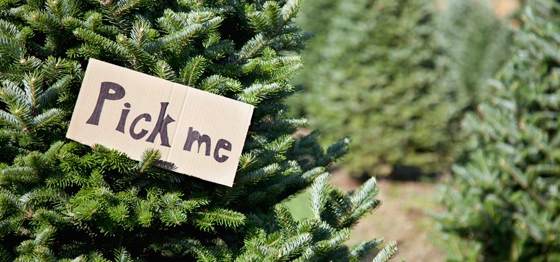By Allison Lind

Spruce up on your Christmas tree knowledge before doing your holiday home decorating this year.
Once a year, we have an important decision to make: Fir or Pine? Fraser or Norway?
For those who celebrate Christmas, the Christmas Tree is the centerpiece of any holiday home decorating. Make sure you get one that fits your needs and style by following our guide to the most common and popular Christmas trees you're likely to find.
[ Also: Caring for Your Christmas Tree | How to Liven Up Your Christmas Wreath ]
Fir Christmas Trees
Types: Douglas, Balsam, Fraser, Noble, White
Douglas Fir
Needles are one inch to one-and-a-half inches and have some of the most fragrant aromas among Christmas trees when crushed. The tree, which is one of the most popular trees for the holidays, is a conical shape. Keep it well watered at all times in order to extend its life through the holiday season.
Balsam Fir
These long-lasting needles are three-quarter inch to one-and-a-half inches and are rounded at the tip. The tree's dark green color has a silvery cast. The fragrance is lasting and pleasing. This is another popular tree for the holidays.
Fraser Fir
Soft-to-the-touch needles are a half inch to one inch long. These pyramid-shaped trees are dark green on top with a silver hue underneath and have a pleasant scent. Strong branches turn upward and hold ornaments well. To care, keep it consistently watered and the tree will have excellent needle retention.
Noble Fir
Needles are one inch long. Nobles are deep green in color, sometimes a bluish or silvery tint, with an unusual (but popular) branch shape. Branches are sturdy with spacing between them, making it easy to hang ornaments as well as hold heavier ornaments. These trees are extremely aromatic and keep very well as long as they're watered regularly.
White (or Concolor) Fir
Needles are typically a half inch to one-and-a-half inches long and are pointed or notched at the tip. Trees are bluish-green when young and turn a dull green with time. They have good needle retention and a nice, citrusy aroma.
Pine Christmas Trees
Types: Scotch, White
Scotch Pine
This tree's vibrant green needles, which are about one inch long, can be sharp, so you may want to wear gloves when decorating. Branches are stiff -- one of the reasons this is one of the most popular Christmas trees. The tree has a nice, long-lasting aroma and good needle retention (about one month). As with all trees, keep it watered, but this pine has a longer survival rate even if left dry for a while (great for the brown thumbs of the bunch!).
White Pine
Needles are two to five inches long in bundles of five. The slender branches of this full-looking tree won't support as many decorations as the Scotch Pine and aren't recommended for heavy ornaments. But its bluish-green color and soft, flexible needles are appealing. It retains needles well when consistently watered, and it has little to no fragrance (great for allergies).
Spruce Christmas Trees
Types: White, Norway, Blue
White Spruce
Short, stiff needles are a half inch to three-quarter inch long and have a blunt tip -- excellent for holding ornaments. When crushed, its needles have an unpleasant odor. But this green or bluish-green tree has the best needle retention among Spruces and a nice, natural shape. Fun fact: It's the state tree of South Dakota.
Norway Spruce
Needles are a half-inch to one inch long. Norways have a shiny, dark green color, a conical shape and strong fragrance. The tree has a short lifespan and needle retention is poor unless it's cut fresh and kept consistently watered, so it's best to purchase about a week or so before Christmas. This is a popular choice in Europe.
Blue Spruce
Needles are three-quarter inches to one-and-a-half inches long. Needles will shed in a warm room, but typically this tree has excellent needle retention. Its stiff branches will support many heavy decorations. Blue Spruces have good form and symmetrical shape, and its name comes from its bluish hue that can also appear silvery. Keep it well watered, especially in warmer rooms (and if possible, keep room temperature as low as is comfortable).
[ Also: Caring for Your Christmas Tree | How to Liven Up Your Christmas Wreath ]
AUTOS | HOBBIES | EDUCATION | FAMILY | FASHION | FOOD & RECIPES | HOME DECOR | RELATIONSHIPS | PARENTING | PETS | TRAVEL | WOMEN
Christmas Trees 101 - About Christmas Trees
Article: Copyright ©